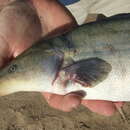Kwando River System Habitat
provided by EOL authors
The Kwando River system is generally construed to consist of the upper Kwando originating in the Angolan headwaters, the middle reach Linyanti swamps and the lower reach Chobe River. The 50 cm western bottlenose mormyrid (Mormyrus lacerda} is a demersal species particularly prevalent in the lower (Chobe) reaches of the river system, where deeper mainstem channels are available. Ion concentrations jgenerally in the rapid flowing river mainstem tends to be low in ionic content; however, swampy areas often contain higher concentrations of nitrate and other ionic components. Correspondingly, planktonic content is only appreciable at these slackwater portions of the river, notably in the Linyanti Swamp. The Kwando waters generally exhibit a lower pH level than the neighboring Okavango River, but have a slightly higher sulfate concentration. The largest native demersal fish species in the Kwando is the 117 centimeter (cm) long tiger fish (Hydrocynus vittatus). Other large demersal native species are the 70 cm Kafue pike (Hepsetus odoe), and the blunt-nosed African catfish (Clarias ngamensis). Each of these demersal vertebrate species are assigned a high trophic level (in the vicinity of level four).
- bibliographic citation
- C.Michael Hogan. 2012. Kwando River. Eds. P.Saundry & C.Cleveland. Encyclopedia of Earth. National Council for Science and the Environment. Washington DC
- author
- C. Michael Hogan (cmichaelhogan)
Diagnostic Description
provided by Fishbase
Diagnosis: dorsal fin greater than twice length of anal fin; dorsal origin nearer tip of snout than caudal fin base; snout 3-3.2 times in head length; caudal peduncle more than 4 times in standard length (Ref. 52193).Description: dorsal fin long; snout elongated (Ref. 13337). Body moderately elongated and compressed; dorsal fin extended, origin in advance of pelvics; caudal forked with partially scaled, rounded lobes; head and forebody smoothly decurved; snout extended to about 1/3 of head, tapered; mouth terminal and relatively small; teeth bicuspid, 7â8 in upper jaw, 8â10 in lower; gill slits on sides only (Ref. 52193).Coloration: greyish brown above, lighter below often with yellowish tinge (Ref. 52193).
Morphology
provided by Fishbase
Dorsal spines (total): 0; Dorsal soft rays (total): 62 - 68; Anal spines: 0; Analsoft rays: 18 - 21
Trophic Strategy
provided by Fishbase
Prefers quiet stretches of river channels, deep pools and floodplain lagoons with aquatic vegetation. Frequency of occurence in Caprivi: occasionally in sandy streams, occasionally on rocky streams, common in standing deep water, occasionally in shallow swamps, and occasionally in shallow flood plains (Ref. 037065). May form small shoals. Feeds mainly on insect larvae, shrimps, small snails and small fish. Known to move up tributaries when they come down in spate and may breed in newly inundated areas (Ref. 13337).
- Recorder
- Drina Sta. Iglesia
Biology
provided by Fishbase
Prefers quiet stretches of river channels, deep pools and floodplain lagoons with aquatic vegetation; may form small shoals; feeds mainly on insect larvae, shrimps, small snails and small fish (Ref. 52193). Known to move up tributaries when they come down in spate and may breed in newly inundated areas (Ref. 13337). Spawns during the rainy season; females carry up to 7,000 eggs; caught by subsistence fishermen and anglers (Ref. 7248, 52193).
Importance
provided by Fishbase
fisheries: commercial; gamefish: yes

